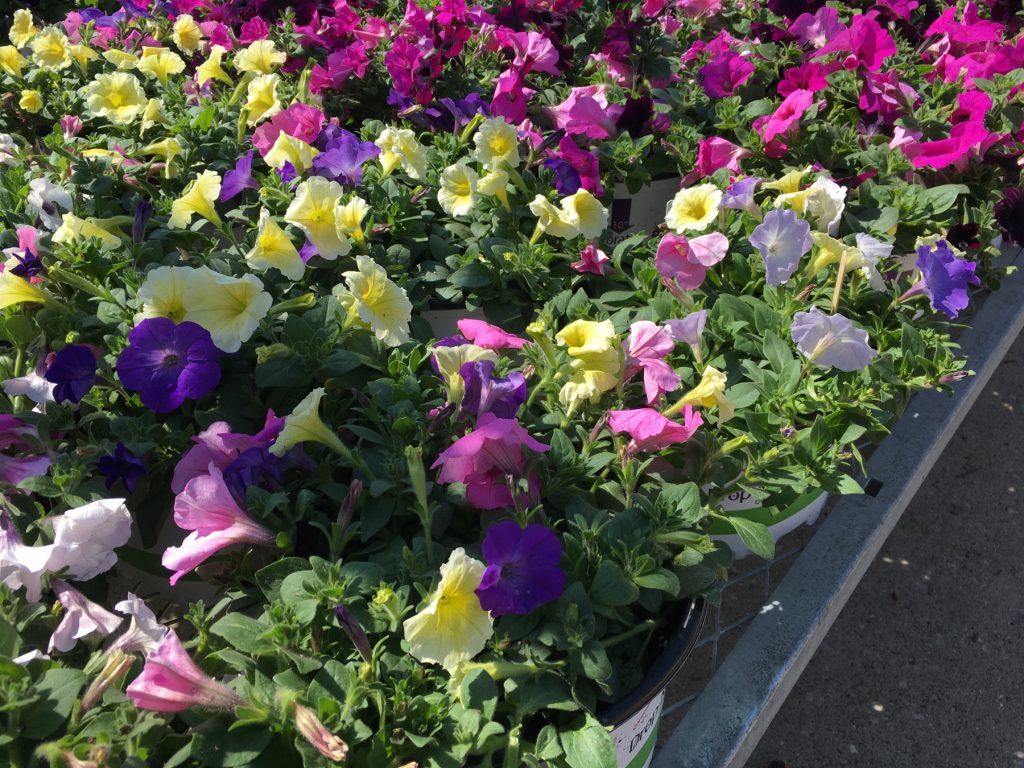
Today, in the third week of April, it snowed in Chicago. Temperatures are still falling below freezing at night. Which is why I’m glad I didn’t buy petunias when I saw them for sale, in full bloom, three weeks ago–on April Fool’s Day, appropriately.
Petunias, with their ruffly bell-shaped flowers, are popular for summer gardens and containers because they are showy and colorful and can tolerate heat and humidity. But they can’t stand freezing. They are tropical plants from South America.
So why on earth would a big-box store in the Chicago suburbs, where freezing temperatures typically occur long into spring, be selling petunias in full bloom at the beginning of April?
For one thing, that chain, with more than 2,000 stores all over North America, buys petunia plants by the millions and sends them everywhere. The chain is too centralized to parse winter hardiness very carefully. In any case, its buyers know that even in the most inappropriate places, any plant in bloom will catch someone’s eye.
Garden shoppers are suckers for flowers, and the garden business knows it. A plant is much more likely to sell if it is blooming. That’s why growers often manipulate light and biochemistry to force perennials into bloom prematurely—so they will be in flower in spring, when most gardeners are shopping, regardless of whether that’s their natural bloom time.
A few feet from the petunias, on April 1, there were pots of perennial catmint covered with blue flowers. Catmint normally doesn’t flower here until the end of May. The store was betting that eager gardeners would buy it, likely without realizing it was flowering out of its time.
What’s the harm? Well, those petunias are dead now, so whoever bought them will have to buy more flowers to replace them. (In fact, I’ll bet the chain store’s buyers are counting on that.) If a perennial has spent some of its bloom in the garden center, it will have less bloom time in your garden. And any gardener who buys a perennial that is in flower months early may be disappointed when it fails to bloom at the regular time.
Most perennials only have enough oomph to bloom once in a season. A lily that is forced to flower for Mother’s Day shoppers will be finished long before its normal bloom time a month or six weeks later. A coneflower that is flowering when you buy it in May is not likely to bloom again at the regular time in July or August.
Some long-blooming perennials, such as that catmint, may be able to manage a little bit of later flowering, especially if they are cut back after their first forced bloom. In future years, most perennials will get back on track: Asiatic lilies will bloom in late May and coneflowers in late summer.
Gardeners can be disconcerted when formerly forced plants revert to flowering at their natural time. You might imagine that a daylily that has flowers when you shop in May is an early-blooming variety, but it isn’t. That plant that was manipulated to manipulate you into buying it. In your garden, free of manipulation, it will bloom next July.
How can you protect yourself? Above all, read the label. Find out whether the plant is an annual, which is supposed to bloom all through the growing season, or a perennial, which blooms every year for just a while. Figure out if it’s frost-hardy. If it’s a perennial, look for the normal bloom time. If you need help deciphering the symbols, get the staff to interpret. If they don’t know, shop somewhere else.
Use your phone to search on the plant name. Find out how hardy it is, when it’s supposed to bloom, and what kind of care it needs. This handy device that is probably right in your pocket is a powerful way to arm yourself with information.

In general, if you shop at locally owned, independent garden centers, you’ll be more likely to find informed staff as well as plants that are chosen to be appropriate for your area. But still, be on your guard against suspect blooms. Even independent garden centers know their customers are more likely to buy flowering plants and may take steps to make plants flower. Don’t be afraid to ask, “Is this the normal bloom time for this plant?”
Personally, I want plants to do their blooming in my garden, not at the garden center. If I’m shopping for perennials in May, I look for healthy foliage and good roots. On a plant that normally blooms in late spring or early summer, I might look for a few flower buds. But I won’t buy a plant that is blooming before it’s supposed to.
If I buy summer-blooming annuals such as petunias or impatiens, I like to see just one or two slightly open flowers, so I’m certain of the color. Otherwise, I look for a lot of flower buds on sturdy, well-branched plants.
The exception is if I’m shopping in spring for cool-season pansies and violas. I depend on them for a punch of color after a gray winter, so I buy them in flower and plant them closely. They can bloom their little hearts out from mid-April until June. By then—when all danger of frost is past—it will actually be the right time for petunias.


